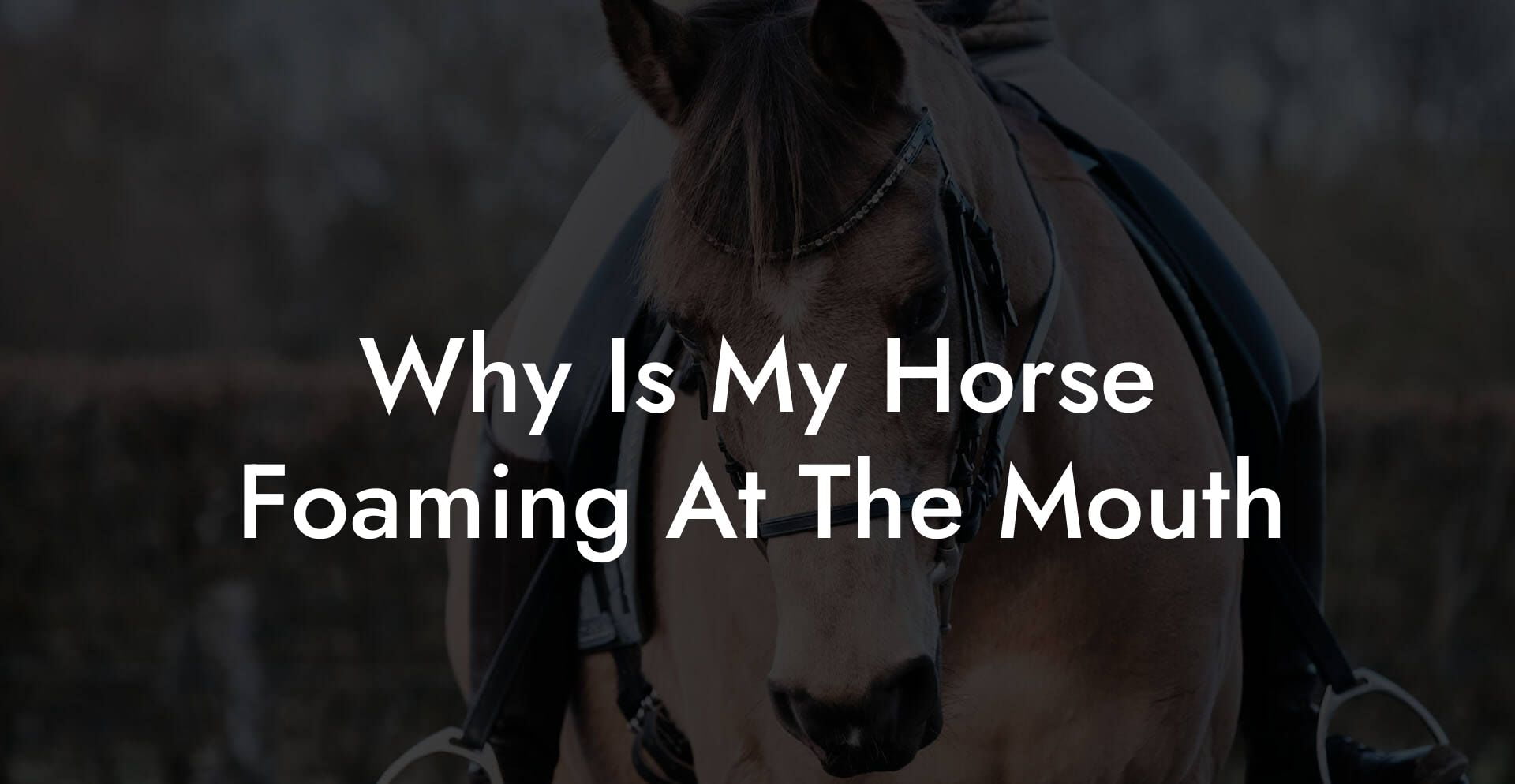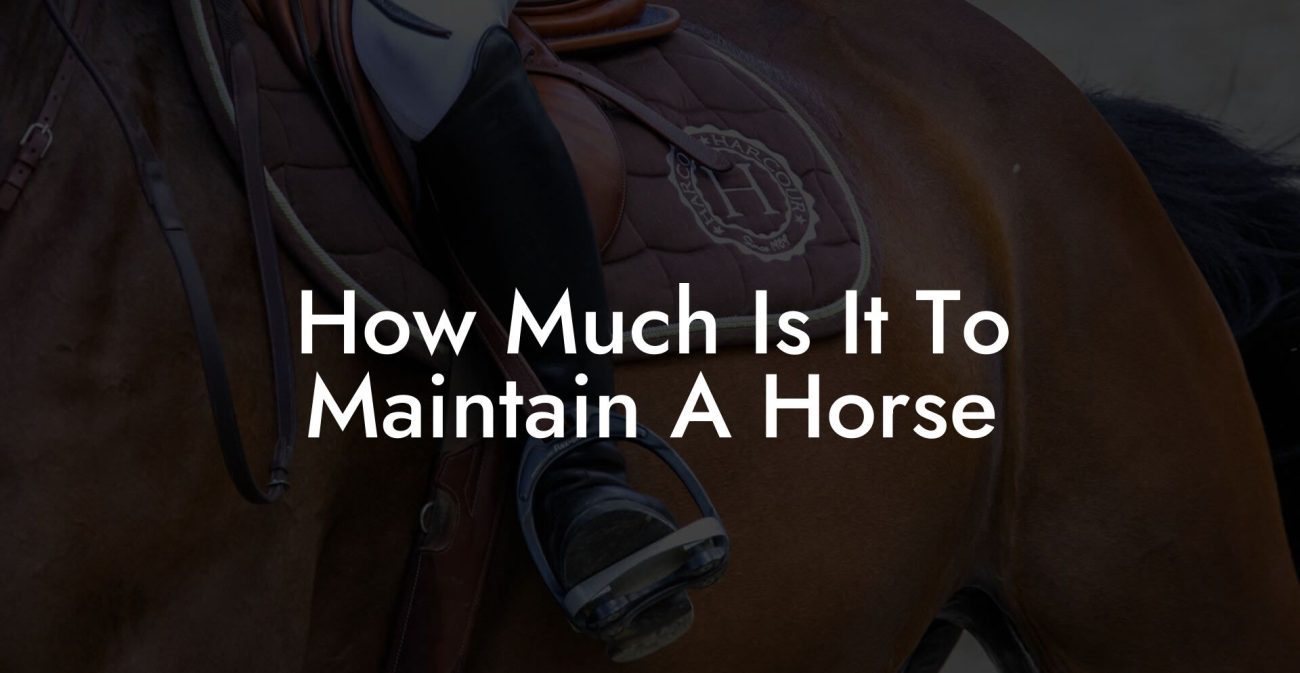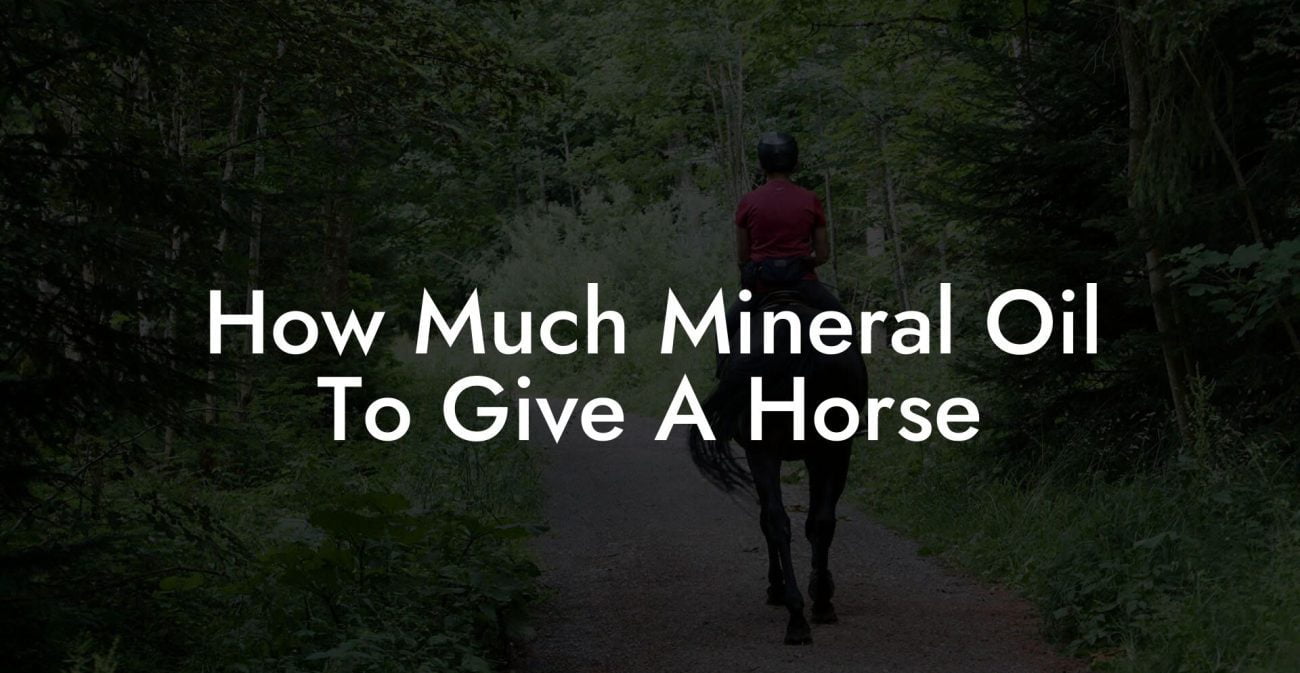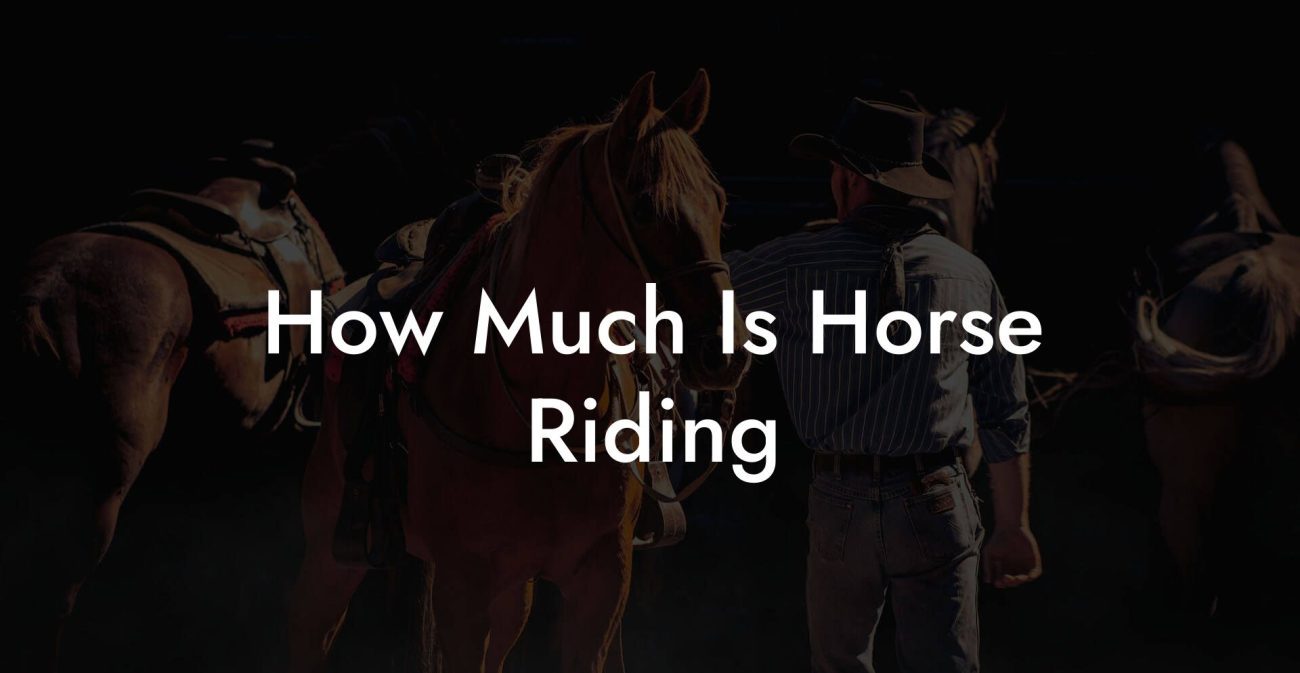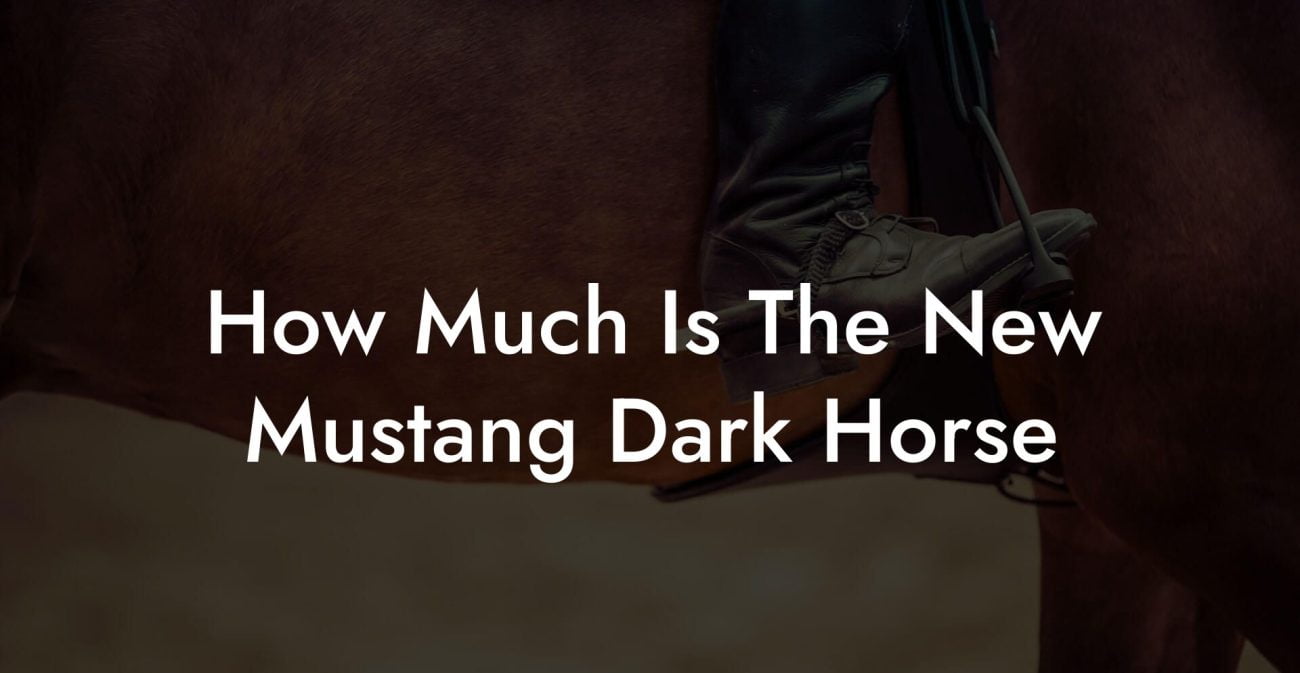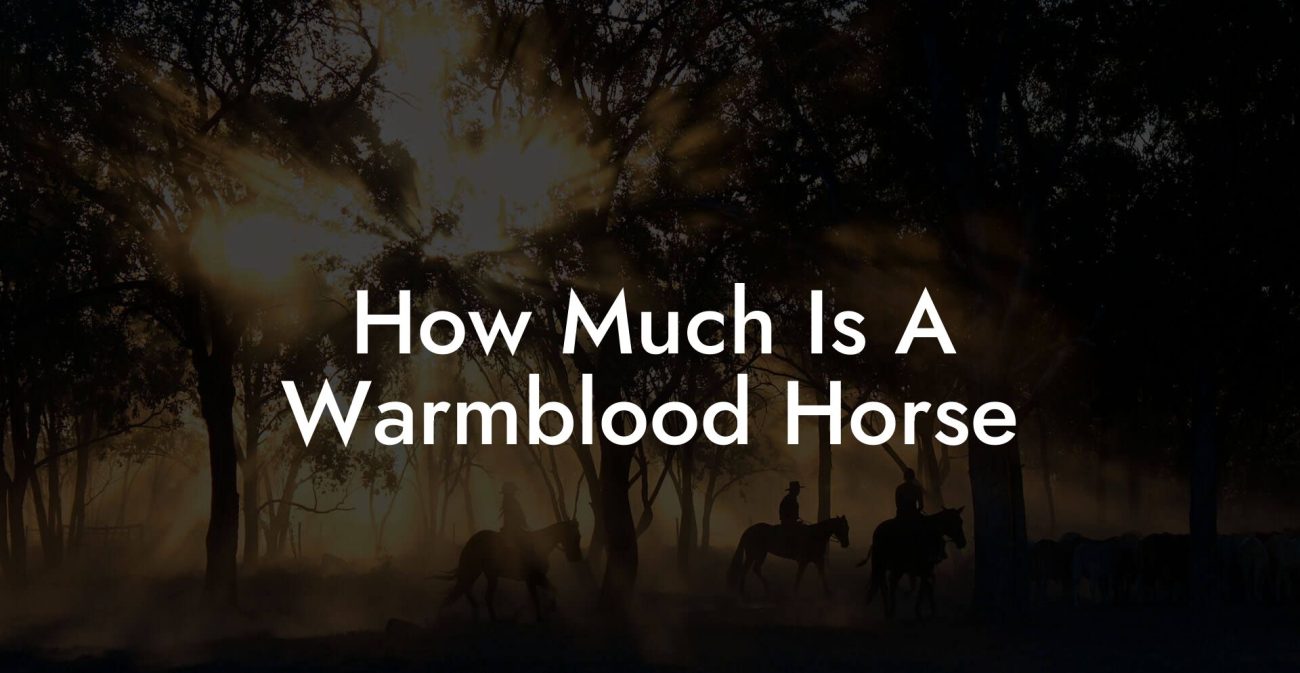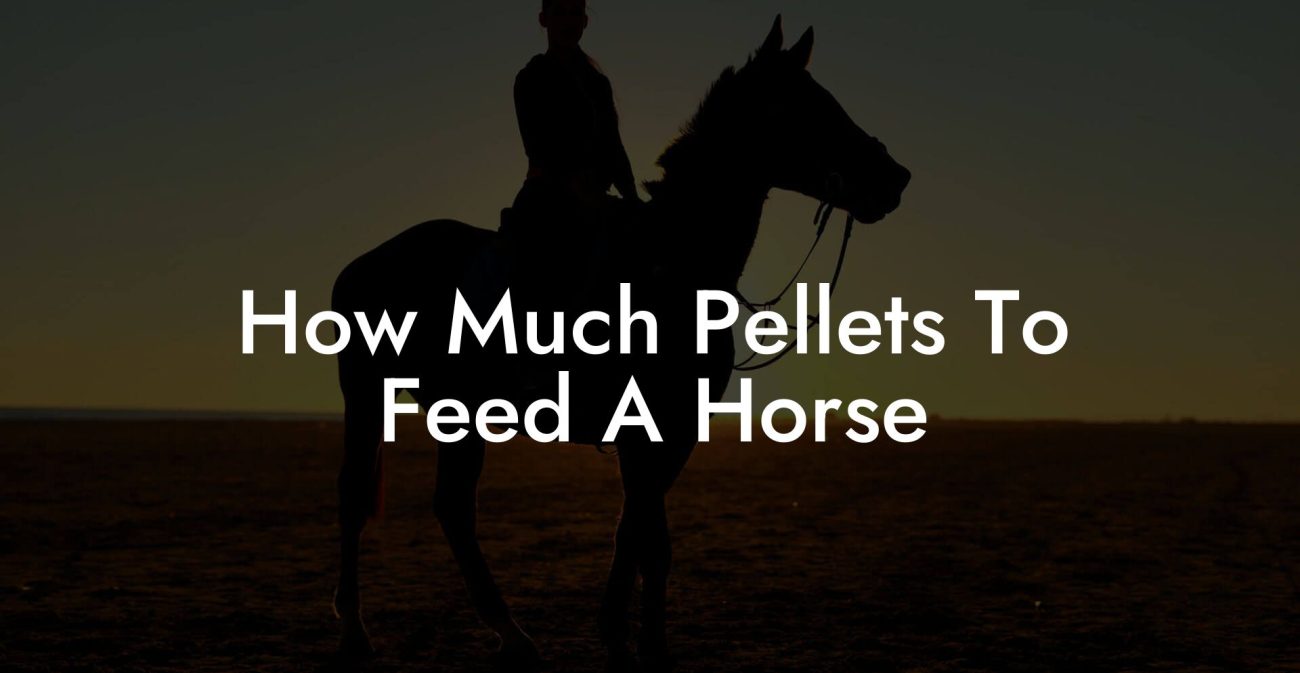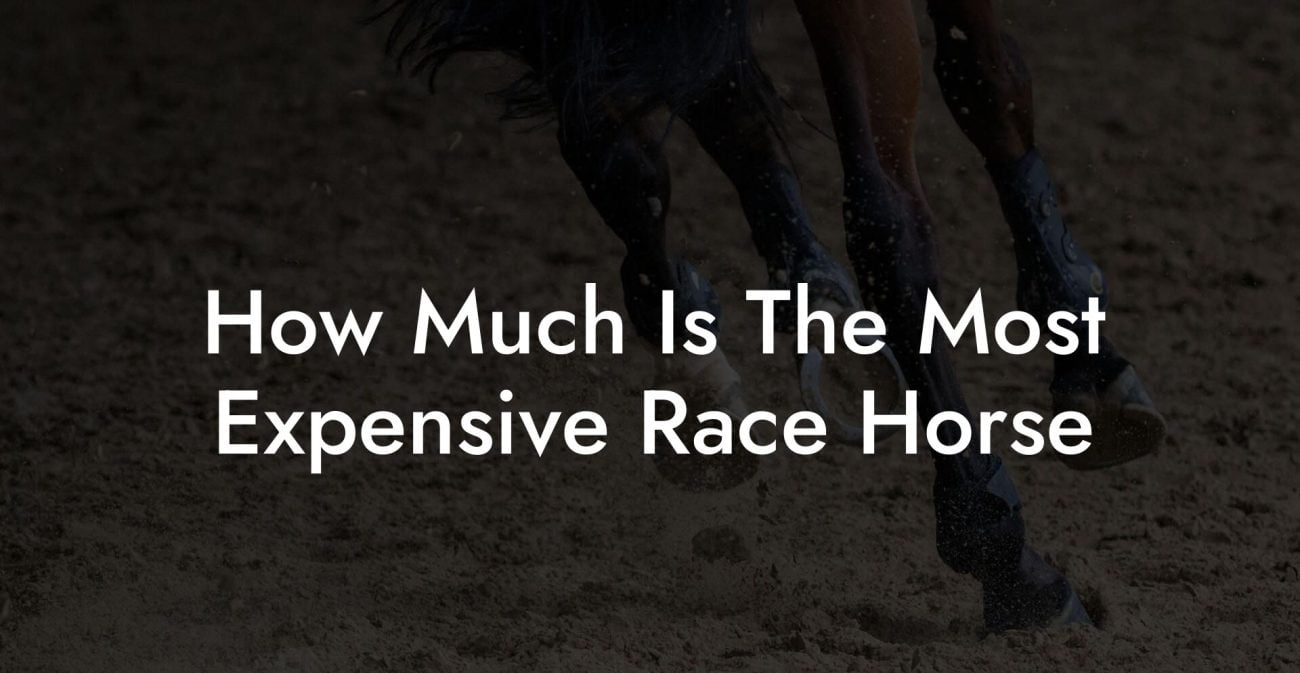Ever witnessed your horse unexpectedly frothing at the mouth and wondered if it’s the latest quirky equine trend or a sign of distress? If your four-legged friend is suddenly sporting a foamy muzzle, it might not be a fashion statement at all, it could be your horse’s way of signaling that something’s not quite right. Let’s dig into the surprising, sometimes alarming phenomenon of a horse foaming at the mouth, and explore everything from common causes and home care tips to when it’s time to contact the vet. Buckle up for an engaging, down-to-earth guide that breaks down this equine mystery in a way that resonates with Gen-Z and millennials who take horse care seriously.
Quick Links to Useful Sections
- What Does It Mean When a Horse Is Foaming at the Mouth?
- Understanding Equine Salivation: Normal vs. Concerning
- Common Causes of Foaming at the Mouth in Horses
- 1. Dental Issues and Oral Injuries
- 2. Digestive Disturbances and Gastric Discomfort
- 3. Toxic Ingestion and Poisoning
- 4. Respiratory or Neurological Conditions
- 5. Stress, Anxiety, and Behavioral Triggers
- 6. Allergic Reactions and Infections
- 7. Exercise-Induced Foaming
- When to Worry: Identifying Emergency Signs
- Home Care and First-Aid Measures
- Maintain a Calm Environment
- Ensure Clean, Fresh Water
- Monitor Feeding and nutrition
- Gentle Oral Care
- Keep a Symptom Log
- Exploring Diagnostic Options: What the Vet Might Do
- Physical Examination and Oral Inspection
- Endoscopy and Imaging
- Blood Work and Toxicology Screens
- Preventative Measures for Equine Mouth Health
- Regular Dental Check-Ups
- Consistent, Balanced Diet
- Stable Environment and Stress Reduction
- Clean and Safe Pasture and Stabling
- Equine Stress and Anxiety: The Hidden Trigger
- Case Studies in Equine Foaming: Learning from Real-Life Experiences
- Case Study 1: Dental Dilemma
- Case Study 2: Gastric Upset and Colic
- Case Study 3: Environmental Toxins and Stress
- Resources and Community Support: Your Next Steps
- Building a Comprehensive Equine Health Maintenance Plan
- Step 1: Routine Health Checks
- Step 2: A Balanced, Nutrient-Rich Diet
- Step 3: Exercise and Mental Enrichment
- Step 4: Environmental Management
- Step 5: Detailed Record Keeping
- Integrating Technology in Modern Horse Care
- FAQ: Your Equine Foaming at the Mouth Questions Answered
- Your Path to Proactive Equine Health
What Does It Mean When a Horse Is Foaming at the Mouth?
When you notice your horse with a frothy coat around its mouth, the immediate reaction is likely a mix of concern and curiosity. While a little drool now and then might be completely normal, persistent foaming can be a sign of an underlying issue that needs attention. Unlike human saliva, equine saliva has its own set of behaviors and functions, ranging from aiding digestion to regulating oral health. However, when the foam turns from normal moisture to something excessive and unusual, it often signals that the horse is struggling with a problem.
Foaming at the mouth can be triggered by several factors including dental issues, digestive disturbances, stress, or even exposure to toxic substances. Understanding the context of when and how this symptom occurs plays a crucial role in diagnosing the problem. Whether your horse has just finished a vigorous workout or is in the middle of an apparent health crisis, the key is to stay observant and informed.
In the world of equine care, every quirk of behavior, from a slight head tilt to an unusual stream of drool, can carry valuable clues about your horse’s well-being. So, if you’re scratching your head over this frothy phenomenon, keep reading to demystify the many potential causes and learn practical steps to keep your horse happy and healthy.
Understanding Equine Salivation: Normal vs. Concerning
Horses naturally produce a significant amount of saliva, which is essential for breaking down food fibers and lubricating feed as they chew. But when the foam becomes persistent or particularly pronounced, it moves beyond a normal physiological response. Here’s a closer look at what's typical and what might be cause for concern:
- Normal Salivation: While grazing or chewing hay, your horse might produce an abundance of saliva. This moisture is usually clear or slightly cloudy, without any foamy texture. It helps with digestion and keeps the mouth comfortable.
- Excessive Foaming: When the foaming is more than just a bit of saliva, it becomes frothy, excessive, or blood-tinged, it can indicate issues like irritation, infection, or internal distress.
- Transient vs. Persistent: A brief bout of foaming after exercise might be normal, but if it lingers or recurs frequently, it’s time to dig deeper into the underlying cause.
By keeping track of your horse’s drooling habits in different situations, you’ll have a better chance of noticing deviations from what’s normal. Perhaps note the time, duration, and any accompanying behaviors like changes in appetite or activity levels, which might help you notice patterns or triggers.
Common Causes of Foaming at the Mouth in Horses
There isn’t just one explanation for a horse foaming at the mouth. Like many equine quirks, this behavior can stem from a myriad of causes. Let’s break down the most common culprits:
1. Dental Issues and Oral Injuries
Just as a toothache can make you wince, dental issues in horses can lead to excessive drooling and froth around the mouth. Overgrown or broken teeth, sharp enamel points, and oral sores not only cause discomfort but can also lead to infections. When chewing becomes painful, your horse’s natural response might be to salivate more than usual.
Regular dental check-ups are essential for horses to prevent such oral health issues. Many foaming cases have been traced back to neglected dental care, which over time can result in significant pain and difficulty in chewing.
2. Digestive Disturbances and Gastric Discomfort
Horses have a delicate digestive system, and any disruption can lead to symptoms including foaming at the mouth. Conditions such as gastric ulcers, colic, or an upset stomach can cause the horse to produce excess saliva. When the stomach is in distress, the resulting nausea and discomfort can lead to a frothy appearance around the mouth.
A diet high in grains or abrupt changes in feeding routines can contribute to digestive issues. Piloting a balanced, consistent feeding schedule is one of the best ways to avoid gastrointestinal upset.
3. Toxic Ingestion and Poisoning
Exposure to toxic plants, chemicals, or spoiled feed is another serious cause of foaming. Poisoning can trigger a cascade of symptoms, and excessive drooling is often an early warning sign. If your horse ingests something harmful, the toxins might irritate the mouth and digestive tract, leading to persistent foaming.
In such cases, immediate veterinary intervention is crucial. Knowing the plants and chemicals in and around your stables can help you mitigate these risks and ensure a safer environment for your horse.
4. Respiratory or Neurological Conditions
Although less common, respiratory issues and certain neurological conditions can also cause a horse to foam at the mouth. Respiratory infections or allergies might lead to labored breathing, increased salivation, and subsequent foaming. Similarly, neurological events such as seizures can manifest with drooling or frothing.
Observing other signs, such as coughing, nasal discharge, or unusual behaviors, can help determine whether the issue is linked to respiratory or neurological distress.
5. Stress, Anxiety, and Behavioral Triggers
Just like humans, horses can experience stress and anxiety. Intense exercise, sudden environmental changes, or even separation anxiety can trigger an overproduction of saliva. For some horses, especially those with a predisposition to nervous energy, the stress response may be visibly expressed through foaming.
Providing a stable, calm environment, along with proper exercise and mental stimulation, can help alleviate this kind of stress-induced foaming.
6. Allergic Reactions and Infections
Allergens in the environment, from pollen to dust mites, can also prompt a reaction in some sensitive horses. Additionally, oral infections or abscesses, often caused by minor injuries or foreign objects in the mouth, might lead to increased saliva production as the body attempts to flush out irritants.
In these instances, the foam can be accompanied by other signs like swelling or redness, indicating that an infection might be at play.
7. Exercise-Induced Foaming
After a vigorous workout, it’s not unheard of for horses to sweat and drool more than usual. Intensive activities, especially in hot weather, may cause a temporary increase in salivation. However, if the foaming continues well after the exercise has ended, it could suggest that there’s another underlying issue.
Monitoring the timing of the foaming, whether it occurs exclusively after exercise or also during rest, can provide valuable insights for further diagnosis.
When to Worry: Identifying Emergency Signs
Although a foamy muzzle might seem benign or temporary, there are scenarios when it demands immediate attention. Recognizing the red flags can help you decide when it’s time to stop scrolling through your social feed and pick up the phone to call your vet.
- Persistent Foaming: If the foaming lasts for several hours or recurs frequently without any clear trigger, it’s a sign that something serious might be going on beneath the surface.
- Accompanying Symptoms: Watch out for additional signs like difficulty breathing, lethargy, changes in eating or drinking habits, or any unusual behavior. These could indicate respiratory distress, pain, or systemic illness.
- Visible Injuries or Bleeding: If the foam is tinged with blood or you notice swellings or cuts inside the mouth, it might be a result of trauma or infection that needs prompt treatment.
- Signs of Poisoning: Rapid onset of symptoms following potential ingestion of a toxic substance requires urgent veterinary care.
When in doubt, it’s always better to err on the side of caution. A quick consultation with your veterinarian can help determine whether the foaming is a benign side effect of temporary stress or a symptom of something more concerning.
Home Care and First-Aid Measures
While professional veterinary care is crucial when serious symptoms manifest, there are some steps you can take at home to manage the situation and ensure your horse remains as comfortable as possible:
Maintain a Calm Environment
Stress can exacerbate many underlying conditions. Keep your horse in a calm, quiet stall or paddock away from any sudden changes or loud noises. Consider playing soothing music or simply ensuring that the area is free from unnecessary disturbances.
Ensure Clean, Fresh Water
Hydration is essential for digestion and overall health. Make sure your horse always has access to clean, fresh water. If foaming is due to dehydration or gastrointestinal distress, providing water might offer some relief.
Monitor Feeding and nutrition
Evaluate your horse’s diet for any recent changes that might trigger digestive issues. Avoid sudden changes in feed and ensure there’s no exposure to moldy or spoiled feed. Small, frequent meals can help maintain steady digestion.
Gentle Oral Care
If dental issues are suspected, gently cleaning the horse’s mouth and checking for loose bits or broken teeth can help. However, always proceed with caution and do not attempt any invasive measures on your own. A professional dental examination is recommended.
Keep a Symptom Log
Jot down when the foaming occurs, its duration, and any other accompanying symptoms. This log will be an invaluable tool when discussing your horse’s condition with your veterinarian.
Remember, these measures are primarily to provide comfort and reduce further stress until you can get professional advice. Home care is the first step, but if symptoms persist or worsen, seeking timely veterinary assistance is imperative.
Exploring Diagnostic Options: What the Vet Might Do
When you call your veterinarian about your horse’s foaming, they’ll likely perform a series of checks to pinpoint the cause. Diagnostic options might include:
Physical Examination and Oral Inspection
A thorough physical exam, including a detailed oral inspection, helps identify signs of injuries, infections, or dental issues. Vets will look for inflammation, wounds, and other abnormalities that might be causing the excessive salivation.
Endoscopy and Imaging
In cases where internal issues are suspected, such as gastrointestinal disturbances, further imaging like ultrasounds or endoscopic examinations might be recommended. These tests can reveal underlying conditions like ulcers or blockages that aren’t visible during a standard exam.
Blood Work and Toxicology Screens
If poisoning or systemic infections are suspected, blood tests and toxicology screens can provide critical information on whether toxins or infections are to blame.
Gaining a clear picture through these diagnostic methods is essential, as it bridges the gap between a symptomatic presentation, such as foaming at the mouth, and identifying the root cause. This precise diagnosis allows your vet to craft an effective treatment plan.
Preventative Measures for Equine Mouth Health
Prevention is always better than cure, and equine health is no exception. By adopting proactive care habits, you can reduce the likelihood of your horse developing issues that lead to excessive foaming at the mouth.
Regular Dental Check-Ups
Scheduling routine dental exams can catch issues like overgrown teeth or injuries early on. Many horses benefit from dental care every six months to a year.
Consistent, Balanced Diet
A diet rich in fiber, with measured amounts of grains and supplements, helps maintain a healthy digestive system. Avoid quick diet changes and pay attention to the quality of hay and feed.
Stable Environment and Stress Reduction
Horses can be sensitive to environmental stressors. Establishing a consistent daily routine, reducing exposure to noisy or chaotic settings, and providing ample space for exercise can guard against anxiety-induced drooling.
Clean and Safe Pasture and Stabling
Regularly inspect your pasture and stable for potential hazards, such as toxic plants or sharp objects that could injure the mouth. Maintaining a clean, hazard-free environment contributes to overall oral and gastrointestinal health.
By incorporating these preventative strategies into your horse care routine, you’re not only tackling the issues that cause foaming but also reinforcing your horse’s overall health and happiness.
Equine Stress and Anxiety: The Hidden Trigger
Life in the fast (or slow) lane isn’t always stress-free for a horse, and just like with humans, stress can manifest in unexpected ways, like leading to excessive frothing. Horses are incredibly perceptive creatures and are often sensitive to changes in their environment. Whether it’s a new stall, changes in routine, or even the presence of unfamiliar horses or humans, stress can trigger physiological responses such as increased salivation.
Consider how you feel when you’re in a high-stress situation, probably a knot in your stomach, a rush of sweat, maybe even a bit of drool if you’re feeling particularly anxious. For horses, stress management is an essential component of overall health. Enriching their environment with regular routines, social interaction with other horses, and sufficient outdoor time can help reduce the chances of stress-related foaming.
If stress or anxiety is a recurring factor, explore integrating calming techniques into your daily horse care. Strategies might include gradual exposure to new environments, using calming supplements as recommended by your veterinarian, and creating a secure and predictable setting that reassures your horse.
Case Studies in Equine Foaming: Learning from Real-Life Experiences
Sometimes the best way to understand an equine health issue is to examine real-life experiences. Below are a few case studies that highlight different causes and how they were addressed:
Case Study 1: Dental Dilemma
Bella, a 12-year-old mare, began showing signs of discomfort while eating and was frequently seen with a foamy muzzle. After a thorough dental exam, her veterinarian discovered several overgrown teeth with sharp points irritating her mouth. Following dental floating and a series of routine cleanings, Bella’s foaming reduced significantly, and she resumed eating normally.
Case Study 2: Gastric Upset and Colic
Rocky, a spirited gelding, was noted foaming at the mouth shortly after his morning turnout. Additional signs of colic were observed, including abdominal discomfort and loss of appetite. Diagnostic procedures confirmed gastric ulcers and mild colic. A modified feeding schedule, dietary adjustments, and medication to soothe the gastrointestinal tract helped Rocky recover and avoid further episodes.
Case Study 3: Environmental Toxins and Stress
Lightning, a young and nervous colt, began to foam excessively during periods of heavy rain and high winds. The stress of unpredictable weather and exposure to a pungent chemical spill in his pasture were pinpointed as the triggers. Mitigating these risks with improved shelter and regularly checking the quality of the pasture produced noticeable improvements in his overall demeanor and reduced foaming.
These examples underscore the fact that while foaming at the mouth can be alarming, understanding the broader context, whether it’s dental, digestive, toxicological, or environmental, enables more targeted and effective interventions.
Resources and Community Support: Your Next Steps
Caring for a horse can sometimes feel like navigating a maze of information, critical decisions, and unique challenges. Whether you’re a seasoned equestrian or just starting out on your horse care journey, tapping into community resources can make all the difference.
First off, consider joining local or online equine communities where members exchange tips, share experiences, and offer support when unusual symptoms like foaming at the mouth emerge. Social media groups, specialized forums, and equestrian clubs are fantastic places to get real-time advice and reassurance from fellow horse lovers.
Don’t hesitate to keep a list of trusted veterinarians and equine dental specialists handy. Regular check-ups, dental reviews, and discussions about any new symptoms ensure that you’re always one step ahead in the health and well-being of your horse.
Additionally, educational resources such as webinars, blog posts, and workshops from reputable equine organizations provide insights into best practices for horse care. They often cover everything from nutrition and grooming to recognizing early signs of distress like abnormal foaming.
Embrace these community support networks and curated resources as your next steps towards proactive, informed, and compassionate horse care. They not only help you troubleshoot when things seem off but also empower you to keep your equine companion thriving in a nurturing environment.
Building a Comprehensive Equine Health Maintenance Plan
A well-rounded approach to horse care involves more than just addressing individual symptoms; it means planning for long-term health management. Here are some actionable steps to ensure your horse remains in peak condition and to reduce the likelihood of issues like unexplained foaming:
Step 1: Routine Health Checks
Schedule regular veterinary visits to monitor not only for common illnesses but also for subtle signs of stress, dental deterioration, and digestive anomalies. A consistent health check routine is crucial for early detection and intervention.
Step 2: A Balanced, Nutrient-Rich Diet
Work with an equine nutritionist to ensure your horse’s diet supports stable gut health and overall vitality. Incorporate high-fiber hay, measured grains, and nutritional supplements as needed to maintain digestive balance. Adjust the diet gradually to avoid shocking the system.
Step 3: Exercise and Mental Enrichment
Regular, moderate exercise coupled with mental enrichment, through interactive games, varied routines, and social interactions with other horses, helps lower stress levels and promote physical well-being. A well-exercised horse is less likely to experience stress-induced symptoms.
Step 4: Environmental Management
Keep your pasture and stabling areas clean, dry, and free from potentially toxic substances. Ensure that shelter and shade are provided in extreme weather conditions, and conduct periodic checks for harmful plants or debris.
Step 5: Detailed Record Keeping
Maintain a comprehensive log of your horse’s health, including feeding schedules, exercise routines, dental care, and response to any treatments. A detailed record helps identify triggers and track improvements over time, making it easier to coordinate with your veterinarian.
Together, these steps create an ecosystem of care that not only addresses immediate concerns like foaming at the mouth but also builds a resilient foundation for long-term equine health.
Integrating Technology in Modern Horse Care
Living in the digital age means you have cutting-edge tools at your disposal to monitor and manage your horse’s well-being. Technology is rapidly transforming the landscape of equine care with innovations that help you keep track of health signals long before they become serious issues.
Modern wearable devices designed specifically for horses can monitor vital signs including heart rate, temperature, and even patterns in movement or drooling. Paired with smartphone apps, these devices allow you to receive real-time alerts when something seems off. This proactive approach can be invaluable in verifying whether symptoms like foaming at the mouth are the result of exercise, dietary changes, or a developing illness.
Moreover, many equine-specific platforms offer telemedicine consultations, making it easier than ever to connect with specialists without leaving the stable. Embracing these innovative tools can significantly enhance your ability to catch early signs of distress and implement preventative measures swiftly.
FAQ: Your Equine Foaming at the Mouth Questions Answered
Below are some of the most frequently asked questions about why horses may foam at the mouth, along with answers that empower you with reliable, actionable information.
1. Why is my horse foaming at the mouth?
Foaming at the mouth in horses can be due to a variety of reasons including dental issues, digestive disturbances, toxic ingestion, respiratory infections, neurological conditions, stress, or even exercise-induced salivation.
2. Is a little foaming normal after exercise?
Yes, a small amount of drool or foam can be normal after intense exercise. However, if the foaming persists beyond the period of physical activity, it may be a sign of an underlying issue.
3. Could my horse’s diet be causing the foaming?
Absolutely. Sudden changes in diet, poor quality feed, or ingestion of moldy hay can lead to digestive upset and extra salivation, which may present as foaming.
4. How can I tell if the foaming is due to dental issues?
If the foaming is accompanied by reluctance to eat, weight loss, or visible sores and uneven wear on the teeth, it could indicate dental problems that need professional attention.
5. When should I contact my veterinarian?
Contact your veterinarian if the foaming is persistent, if it’s accompanied by other symptoms such as lethargy, changes in appetite, difficulty breathing, or if there’s any sign of pain or bleeding.
6. Can stress really cause a horse to foam at the mouth?
Yes, excessive stress and anxiety in horses can lead to an overproduction of saliva resulting in foaming, especially when combined with environmental changes or disruptions in routine.
7. What are some home care tips while waiting for veterinary advice?
Keep your horse in a calm environment, provide clean water, monitor its diet, and record any other symptoms. This information can be very helpful for your veterinarian.
8. Are there any technological tools that can help monitor my horse’s condition?
Yes, modern wearable devices equipped with sensors can track vital signs and behavioral patterns, alerting you to any abnormalities that may signal health issues.
9. Can foaming at the mouth indicate poisoning?
Absolutely. Exposure to toxic plants or chemicals can cause severe reactions in horses, including foaming at the mouth. Immediate veterinary care is essential in such cases.
10. What preventative measures can reduce the risk of my horse developing this symptom?
Regular dental and health check-ups, a balanced diet, gradual changes in routine, good environmental management, and stress reduction are all key to preventing issues that lead to foaming.
Your Path to Proactive Equine Health
While a horse foaming at the mouth can initially send your heart racing, remember that knowledge is power, and you now have a comprehensive playbook to tackle this issue head-on. From identifying potential causes and understanding the nuances of equine salivation to implementing preventative measures and knowing when to seek professional help, the path to ensuring your horse’s comfort and health is well within your grasp.
Every horse is a unique individual with its own quirks and needs. By staying vigilant, embracing both traditional care methods and modern technology, and fostering a deeply caring environment, you’re not just addressing a symptom but building a foundation for long-term well-being.
Whether it’s managing daily routines, setting up community support networks, or integrating innovative monitoring devices, every small step contributes to a healthier, happier life for your horse. This is your call to action, combine your passion for equine care with the latest insights and tools, and transform what might seem like a puzzling problem into an opportunity for comprehensive health and enhanced connection with your horse.
Embark on this journey with confidence, knowing that with the right mix of resources, expertise, and heart, you can keep your equine companion thriving. The adventure of modern horse care is as much about precision and preventive practices as it is about nurturing trust, communication, and resilience. And in doing so, you’re not only safeguarding your horse’s health, you're also fostering a lifelong bond built on care, commitment, and understanding.

